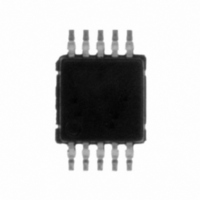LM3354MM-1.8/NOPB National Semiconductor, LM3354MM-1.8/NOPB Datasheet - Page 9

LM3354MM-1.8/NOPB
Manufacturer Part Number
LM3354MM-1.8/NOPB
Description
IC CONV DC/DC BUCK/BOOST 10MSOP
Manufacturer
National Semiconductor
Type
Step-Down (Buck), Step-Up (Boost), Switched Capacitor (Charge Pump)r
Datasheet
1.LM3354MM-4.1NOPB.pdf
(12 pages)
Specifications of LM3354MM-1.8/NOPB
Internal Switch(s)
Yes
Synchronous Rectifier
No
Number Of Outputs
1
Voltage - Output
1.8V
Current - Output
90mA
Frequency - Switching
1MHz
Voltage - Input
2.5 ~ 5.5 V
Operating Temperature
-40°C ~ 85°C
Mounting Type
Surface Mount
Package / Case
10-MSOP, Micro10™, 10-uMAX, 10-uSOP
For Use With
LM3354-1.8EVAL - BOARD EVALUATION LM3354-1.8
Lead Free Status / RoHS Status
Lead free / RoHS Compliant
Power - Output
-
Other names
LM3354MM-1.8
LM3354MM-1.8TR
LM3354MM-1.8TR
Ceramic
Tantalum
Polymer Electrolytic
ESR
Relative Height
Relative Footprint
Temperature Stability
Frequency Stability
V
V
dv/dt of V
Filter Capacitor Selection
iii) Polymer Electrolytic
Polymer electrolytic is a third suitable technology. Polymer
capacitors provide some of the best features of both the
ceramic and the tantalum technologies. They provide very
low ESR values while still achieving high capacitance val-
ues. However, their ESR is still higher than the ceramics,
b) CAPACITOR SELECTION
i) Output Capacitor (C
The output capacitor C
the output ripple voltage so C
lected. The graphs titled V
Performance Characteristics section show how the ripple
voltage magnitude is affected by the C
capacitor technology. These graphs are taken at the gain at
which worst case ripple is observed. In general, the higher
the value of C
lighter loads, the low ESR ceramics offer a much lower V
ripple than the higher ESR tantalums of the same value. At
higher loads, the ceramics offer a slightly lower V
magnitude than the tantalums of the same value. However,
the dv/dt of the V
electrolytics is much lower than the tantalums under all load
conditions. The tantalums are suggested for very low profile,
small size applications. The ceramics and polymer electro-
lytics are a good choice for low ripple, low noise applications
where size is less of a concern.
ii) Input Capacitor (C
The input capacitor C
input ripple voltage, and to a lesser degree the V
OUT
OUT
Ripple Magnitude
Ripple Magnitude
OUT
Ripple
OUT
, the lower the output ripple magnitude. At
OUT
@
IN
ripple with the ceramics and polymer
IN
OUT
All Loads
OUT
directly affects the magnitude of the
Taiyo-yuden
AVX
Sprague/Vishay
Nichicon
Cornell-Dubilier (ESRD) (508) 996-8561
Sanyo (POSCAP)
@
@
)
OUT
<
>
)
directly affects the magnitude of
50 mA
100 mA
Manufacturer
Ripple vs. C
OUT
should be carefully se-
TABLE 1. Comparison of Capacitor Technologies
OUT
OUT
TABLE 2. Capacitor Vendor Information
Lowest
Low for Small Values (
Higher Values
Large
X7R/X5R-Acceptable
Good
Low
Low
Lowest
(Continued)
value and the
in the Typical
OUT
OUT
(408) 573-4150
(803) 448-9411
(207) 324-4140
(847) 843-7500
(619) 661-6322
ripple.
ripple
OUT
Ceramic
Tel
9
<
and their capacitance value is lower than the tantalums of
the same size. Polymers offer good frequency stability (com-
parable to ceramics) and good temperature stability (compa-
rable to tantalums). The Aluminum Polymer Electrolytics
offered by Cornell-Dubilier and Panasonic, and the POS-
CAPs offered by Sanyo fall under this category.
Table 1 compares the features of the three capacitor tech-
nologies.
A higher value C
low input and output ripple as well as size a 10 µF polymer
electrolytic or ceramic, or 15 µF tantalum capacitor is rec-
ommended. This will ensure low input ripple at 90 mA load
current. If lower currents will be used or higher input ripple
can be tolerated then a smaller capacitor may be used to
reduce the overall size of the circuit. The lower ESR ceram-
ics and polymer electrolytics achieve a lower V
the higher ESR tantalums of the same value. Tantalums
make a good choice for small size, very low profile applica-
tions. The ceramics and polymer electrolytics are a good
choice for low ripple, low noise applications where size is
less of a concern. The 10 µF polymer electrolytics are physi-
cally much larger than the 15 µF tantalums and 10 µF
ceramics.
iii) C
A 1 µF, X7R ceramic capacitor should be connected to pin
C
internal supply rail of the LM3354.
Of the different capacitor technologies, a sample of vendors
that have been verified as suitable for use with the LM3354
are shown in Table 2.
10 µF); Taller for
FIL
. This capacitor provides the filtering needed for the
FIL
(408) 573-4159
(803) 448-1943
(207) 324-7223
(847) 843-2798
(508) 996-3830
(619) 661-1055
IN
will give a lower V
Fax
High
Lowest
Small
Good
Acceptable
High
Slightly Higher
High
Tantalum
www.t-yuden.com
www.avxcorp.com
www.vishay.com
www.nichicon.com
www.cornell-dubilier.com
www.sanyovideo.com
IN
ripple. To optimize
Website
Low
Low
Largest
Good
Good
Low
Low
Low
IN
Electrolytic
www.national.com
Polymer
ripple than














